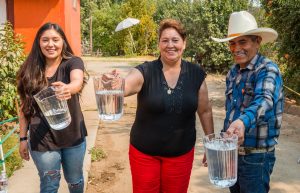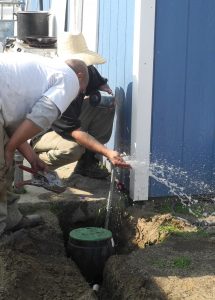
During the recent multi-year drought, the wells of some 300 homes and properties in East Porterville went dry. Last month saw the completion of Phase 2 of a county, state and city project connecting more than 750 homes from the area, east of Porterville city limits, along with some others in and around the city, to the city’s water supply.
With wells drying up, county residents began running out of water. Governor Jerry Brown declared a state of emergency, allowing the state’s Department of Water Resources (DWR) to allocate much needed funding to help with the situation. With the aid of Self Help Enterprises, temporary non-potable water tanks were set up and filled on a regular basis, and drinking water was delivered to the residents.
And, while it seemed to get off on rather a rocky start, city and county officials came together with a new well, which has been added to the Porterville water system to balance the addition of new users to the city’s water systems. Two additional city wells are currently under development along with an additional tank, according to Porterville City Manager John Lollis.
Phase 1 of the East Porterville Water Supply Project began in January, 2016 with the construction of pipes connecting some of the homes to the city – there was no cost to participating homeowners. Hookups were prioritized on a first to signup, first-served basis. Roughly some 300 households were hooked in by March, 2017.
In Phase 2, another 450 homes have been hooked in – some of which had not run dry on their private wells, but opted for the free hook-in option, while available. Approximately 1,100 property owners were invited to participate. Some of these are still getting hooked in before funding runs out.
The total cost of the project has been approximately $70 million, and has been paid for through grant funding from the DWR emergency funds, Lollis said.
Early on, as water became a major problem in the area, Self-Help Enterprises offered to step in offering its help.
“If we can do anything, we’d like to do it,” Jessi Snyder, Self-Help’s community development manager said the non-profit offered.
Because of Self-Help’s contacts through its construction business helping low-income families, as well as potential home owners making their dreams become realities, coming up with contractors to perform the public works-related construction for water infrastructure and individual hook-ups was a natural fit. Also, Self-Help can more easily enter private property than city, county or state personnel, Snyder said.
“Because of the emergency, we were able to just contract out,” she said. The process of going out to bid was not required, as time was critical. Work was done in coordination with Community Services Employment Training (CSET), which helped provide individual meter setups for households.
Once these matters were in place, the DWR was able to move forward with contracting for the big infrastructure, she said, which included some 15 miles with big pipes.
One catch for homeowners, especially those who still had their own well water, is that they had to agree to give up those old, personal wells, to hook into the city system. Those wells were and continue to be destroyed and removed by Self Help.

There are still approximately 80 homes budgeted to receive hookups into the system, 26 of which still have temporary water tanks. With an abundance of rainfall in the 2016-17 season, the governor declared the drought emergency over in April 2017. An exception was made for some San Joaquin Valley communities where there were still dry wells. Financing for new wells and water issues in those areas was to continue for 15 months, which means funding will run out in June.
There are still about 250 homeowners who have asked for assistance, Snyder said. The funding will also run out for the temporary tank service.
“We’re running out of time,” she said, “and not everyone will be taken care of and applications are still trickling in. Those who do not receive funding by the June deadline, will have to take care of their water issues on their own, unless additional allocations are made or a new state drought emergency is declared.”

While I do not have a suggestion for an alternative solution to this situation, we need to be clear-eyed about the costs here. If this project cost $70 million to hook up 750 homes, that is nearly $100,000 per home.
I owned, then sold, a modest home in unincorporated East Porterville for about half that in the 1980’s. This kind of financial insanity can not be a model for the future.
I believe it was much closer to $40M.